Longest Lasting Roof Type
When it comes to investing in your property, few decisions are as significant as choosing the right roofing material. Not only does your roof safeguard your home or business from the elements, but it also plays a pivotal role in your property’s overall aesthetics and value. Among the many options available, one question looms large: What is the longest lasting roof type?
Every property is unique, and its roofing requirements reflect that. The team of B&M Roofing takes the time to assess your property’s specific needs, considering factors such as climate, architectural style, budget constraints, and long-term goals. Our experts offer tailored recommendations that align with your individual preferences and requirements.
In this article, we’ll explore what is the longest lasting and most durable roof type and material that can stand the test of time.
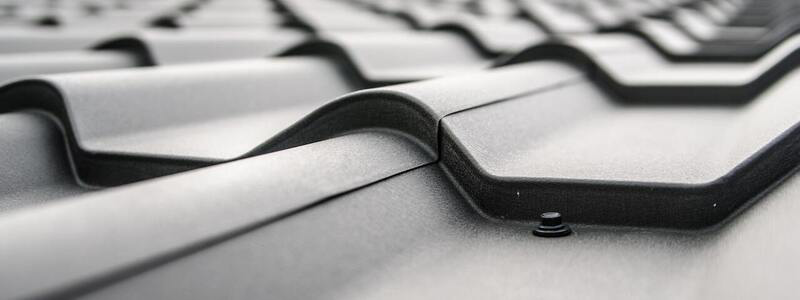
The Quest for the Longest Lasting Roof Type
Roofing materials vary widely in terms of lifespan, durability, and resilience. The longest-lasting roof type is one that strikes a harmonious balance between all these factors, providing you with decades of protection without constant maintenance or repairs. While there are several contenders, one material consistently stands out as the front-runner in terms of longevity and strength: slate roofing.
Slate Roofing: A Timeless Triumph
When it comes to a roof that’s not only built to last but also exudes an air of timeless elegance, slate roofing takes the crown. Crafted from natural stone, slate shingles offer a remarkable lifespan that can extend well beyond a century. This makes them a compelling choice for home and business owners seeking a roofing solution that doesn’t just provide shelter but tells a story of enduring quality.
What Makes Slate Roofs Last So Long?
The secret to the remarkable longevity of slate roofs lies in the material’s exceptional properties. Slate is a metamorphic rock formed from layers of sedimentary rock subjected to immense pressure and heat over time. This unique formation process results in incredibly dense slate, resistant to water absorption and impervious to temperature fluctuations. As a result, slate shingles maintain their structural integrity and appearance for decades, if not centuries.
The Perks of Opting for Slate
- Unmatched durability: Slate’s durability is practically unparalleled. It can withstand harsh weather conditions, including heavy rain, hail, snow, and high winds, without showing signs of wear or deterioration. A roof made of good slate installed properly on a strong support structure is common to last a couple of centuries or even more.
- Low maintenance: Unlike many other roofing materials that require frequent repairs or replacement, slate roofs demand minimal maintenance. The general idea is set it and forget it. Their resistance to water and other elements means you won’t have to worry about rot, mold, or other common roofing issues.
- Aesthetic appeal: Slate roofing adds an undeniable aesthetic charm to any structure beyond its practical benefits. Its natural, earthy tones and unique texture can enhance the architectural beauty of your home or business.
- Eco-friendly choice: Slate is a natural material that doesn’t require chemical treatments or manufacturing processes. Choosing slate is a sustainable choice that contributes to reducing your environmental footprint.
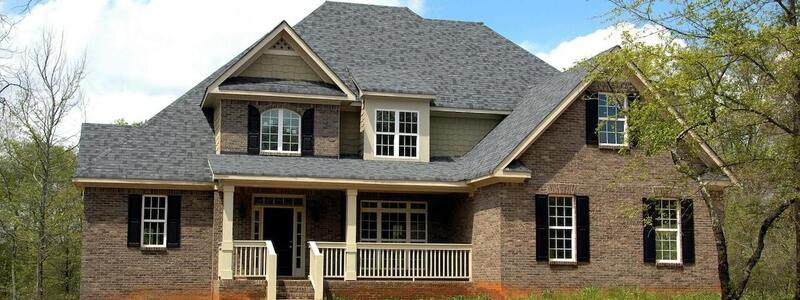
The Strength of the Alternatives
Selecting the suitable roofing material involves more than just aesthetic considerations. The decision can impact your property’s integrity, longevity, and value. When longevity is paramount, slate roofing emerges as the undisputed champion. Its innate durability, resistance to the elements, and timeless beauty make it an investment that pays dividends for generations. However, the alternatives, such as metal, concrete, and clay tile roofing, also offer impressive lifespans and unique benefits.
Metal Roofing: Enduring Excellence
Metal roofing has earned its reputation for durability by being an exceptional choice for homeowners and business owners seeking a long-lasting roofing solution. Though it feels like a modern solution, it has been around for centuries. The grayish rooftops of Paris get their color from zinc sheets first installed in the 1800s. The green color on many famous church domes is testimony to the theoretical conclusion that copper roofs can last 1000 years! And what other proud proof of copper sheet longevity than the Statue of Liberty itself?
This roofing category includes various metals, such as steel, copper and sometimes aluminum, each offering its unique benefits. Metal roofs typically provide a lifespan ranging from 40 to 70 years, contingent on factors like the specific material used and the level of maintenance upheld.
Why Metal Roofs Shine?
- Weather resilience: Metal roofs are engineered to withstand various weather conditions. They effortlessly shed snow, resist rainwater penetration, and endure high winds. This resilience makes them an excellent option for regions with extreme weather patterns.
- Durability: Metals like steel copper and aluminum possess inherent strength, ensuring that metal roofs hold up against impacts from hail, falling debris, and other potential hazards.
- Minimal maintenance: One of the key advantages of metal roofing is its low maintenance requirement. Metal roofs remain largely unaffected by these common issues, unlike materials that may succumb to rot, pests, or decay over time.
- Energy efficiency: Metal roofs often incorporate reflective coatings and various insulating layers that help reflect sunlight and heat away from the building, contributing to better energy efficiency and potential utility savings.
Concrete Tile Roofing: The Longevity of Concrete
Concrete tile roofing is a steadfast choice when longevity is a top priority. These tiles are known to endure for approximately 50 to 100 years, making them an investment that offers lasting protection. Concrete tiles are fashioned from a mixture of sand, water, and cement, which is then molded into shapes and cured to create robust roofing material.
Why Concrete Tiles Endure?
- Fire and pest resistance: Concrete tiles are non-combustible, rendering them highly fire-resistant. Additionally, their composition deters pests and rodents, enhancing the overall longevity of the roof.
- Color retention: These tiles are often pigmented with durable color coatings, which means they retain their appearance over the years, even in the face of constant exposure to the elements.
- Climate adaptability: Concrete tiles are engineered to withstand diverse climates. They can handle freeze-thaw cycles without cracking, crucial for regions prone to temperature fluctuations.
Clay Tile Roofing: The Classic Choice
Clay tile roofing carries an air of timelessness, dating back 5,000 years to glazed earthenware rooftops in China, and elegance that few other materials can match. Beyond its aesthetic allure, clay tile roofing boasts an impressive lifespan of 75 to 100 years or even more, making it a choice that resonates with history and longevity. In the quest for the longest lasting roof type, clay tile roofing is a strong candidate.
The Strengths of Clay Tiles
- Distinct aesthetic: The warm, earthy tones of clay tiles contribute to a unique Mediterranean or Spanish architectural style that enhances the visual appeal of any property.
- Weather endurance: Clay tiles are naturally resistant to extreme weather conditions, including UV radiation, high winds, and heavy rainfall.
- Fire resistance: Similar to concrete tiles, clay tiles are fire-resistant, which can provide peace of mind for homeowners concerned about fire hazards.
- Eco-friendly: Using natural clay and the absence of synthetic materials make clay tile roofing an environmentally friendly choice.
Asphalt Shingles: A Balance of Affordability and Durability
Asphalt shingles are a popular choice for their balance between affordability and durability. While they might not match the longevity of slate or concrete tiles, high-quality asphalt shingles can still offer a respectable lifespan of around 20 to 30 years.
The Benefits of Asphalt Shingles
- Cost-effectiveness: Asphalt shingles are often more budget-friendly than other roofing materials, making them an accessible choice for homeowners seeking durability without breaking the bank.
- Variety: These shingles come in a wide range of colors, styles, and textures, allowing you to find a look that complements your property’s aesthetics.
- Ease of installation and repairs: Asphalt shingles are relatively lightweight and easy to install or replace, saving labor costs during installation and any necessary repairs.
- Weather resistance: High-quality asphalt shingles are designed to withstand various weather conditions, including moderate wind and rain.

Longest Lasting Roof Type – B&M Roofing
Different roofing materials come with distinct advantages and potential drawbacks. B&M Roofing’s professionals are well-versed in the strengths and weaknesses of each material, enabling them to guide you toward the most suitable option based on your desired lifespan, aesthetic preferences, and maintenance expectations.
As you weigh your options, remember that a roof is more than just a protective covering; it’s a statement of durability, elegance, and longevity. Whether you’re looking to add character to your home or safeguard your business, the longest-lasting roof type will stand as a testament to your wise choice for years to come.
What Are Roofing Shingles Made Of
When it comes to protecting your home or business from the elements, few things play a more crucial role than the roof over your head. Roofing shingles, those overlapping, layered pieces that cover the surface of your roof, play a significant role in safeguarding your property and adding to its visual appeal. If you’ve ever asked yourself what materials roofing shingles are made of, you’re in the right spot.
In pursuing the ideal roofing solution, professional guidance can make all the difference. With an overwhelming array of roofing options and materials available, making an informed decision requires a comprehensive understanding of the unique characteristics of each material and its compatibility with your property.
Let’s look in-depth at roofing shingles, their composition, different types, and everything that falls within these categories.
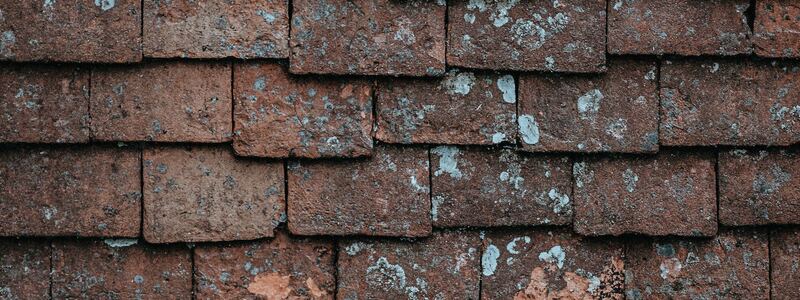
What Are Roofing Shingles Made Of Today?
Roofing shingles have come a long way from their humble beginnings. Today, they’re made from various materials that offer durability, longevity, and aesthetic value. While various types of shingles exist, the most common materials include asphalt, fiberglass, wood, metal, ceramic, concrete, slate, synthetic materials like rubber and plastic, and even solar shingles. These materials are carefully chosen to provide the best combination of looks, strength, weather resistance, insulation, and overall performance.
The Most Common Roof Shingle Material: Asphalt Shingles
Asphalt shingles are the most prevalent choice for roofing materials across the United States. If one had to answer the question of “What are roofing shingles made of?” with one word, that word would definitely be asphalt. These shingles comprise fiberglass or organic mat coated with asphalt and mineral granules. They balance affordability and reliability, making them an attractive option for homeowners and business owners.
Organic asphalt shingles contain more asphalt than fiberglass shingles, so they are generally more durable in punishing weather. Being heavier, they are more likely to withstand hail and frost without cracking. But because of their organic nature, they absorb more water and may warp; being heavier than fiberglass adds load to your roof, and they are less fire resistant.
Fiberglass asphalt shingles are lighter on the supporting structures and may not be as durable in stormy conditions, but their fiberglass core lasts better than their organic counterparts.
Modern asphalt shingles are engineered to resist harsh weather conditions, UV radiation, and even the impact of hail. Their construction allows for flexibility while maintaining structural integrity, which is crucial for withstanding temperature changes and natural movements of your home.
Do Roof Shingles Contain Asbestos?
Due to its fire-resistant and insulating properties, asbestos was used in construction materials, including roofing shingles. However, since the health risks associated with asbestos became well-known, its use in building materials was phased out. Therefore, roofing shingles manufactured today do not contain asbestos. Modern shingles are made with safety as a top priority, using materials that provide protection and peace of mind.
Avoid repairing your roof by yourself; opt for an expert roofing contractor to do the job.
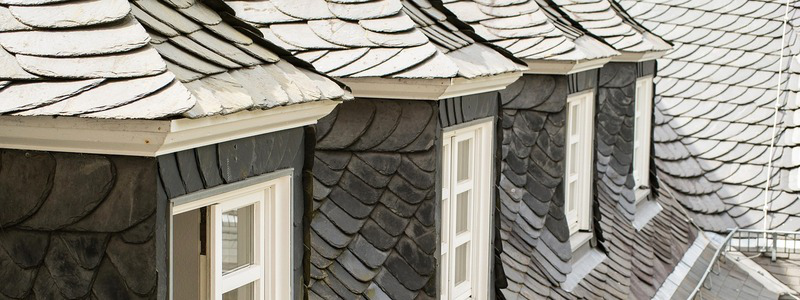
What Are Roofing Shingles Made Of Besides Asphalt?
There is a diverse range of materials for roofing shingles. From the cost-effective qualities of asphalt to the enduring elegance of slate and the resilience of metal, each material offers its own set of advantages. Let’s see the different types of roof shingles:
Asphalt Shingles:
Asphalt shingle roofs are the most affordable for materials and installation. They are the most common choice of roof replacement material or new home roof installations. There are two main types of asphalt shingles, organic asphalt and fiberglass. They both come in three-tab or architectural styles.
3-tab asphalt shingles are a decent choice when on a tight budget, but they are thinner and wear out more quickly. Architectural shingles have an extra laminate layer that gives them contours and textures and can mimic other materials, providing an affordable and elegant alternative to the traditional flat 3-tab shingle.
Wood Shingles and Wood Shakes:
Wood shingles add a touch of natural beauty to your roof. Typically made from cedar or redwood, they offer excellent insulation and a charming, traditional look. However, they require more maintenance than some other shingle types. A more rustic option is wood shakes, where the wood tiles are hand split to give a rougher classy look. Wood shakes, typically cedar being split by hand, are the thickest wood roofing material on today’s market, providing better protection against heavy rain, hail and strong winds.
Metal Shingles:
Metal shingles, often made from materials like aluminum, copper, or steel, are known for their longevity and durability. They can last several decades and provide exceptional protection against the elements. An old-time classic with many modern variations, metal roofing, can be seen on centuries-old European buildings, many old church domes and several very modern structures. Relatively easy to install and lightweight, metal shingles are a good choice, especially when the roof support system is not very strong.
At B&M Roofing, we can help you explore options that offer durability and aesthetics while remaining within your financial comfort zone.
Clay tiles:
Clay tiles are made of all-natural materials and will maintain their rich earth tones and classic appearance for 100 years. They are fire-resistant and will not burn. They do not need much maintenance, and while they are usually seen in warmer climates, they work well in most environments.
However, they can be heavy, and the supporting structure may need reinforcement before opting for the relatively permanent solution of clay tiles.
Concrete Shingles:
These shingles are known for their robust nature, offering excellent resistance against harsh weather conditions, including heavy rains and strong winds. Their weight provides stability and longevity, making them a reliable option for long-term roofing solutions.
Synthetic Shingles:
As technology advances, so do our roofing options. Synthetic shingles, made from rubber, plastic, or polymer materials, offer a range of benefits, such as affordability, lightweight construction, and ease of installation.
Rubber shingles can look very similar to asphalt shingles. Their characteristics, cost and lifespan depend on the type of rubber, from the most affordable TPO and PVC to the most expensive EPDM roof.
Composite plastic shingles are another very affordable synthetic alternative. They can be shaped and colored to imitate pretty much anything and they are very light, which makes them easy to install and very forgiving for any weaknesses of the support structure. But they are not as long-lasting as most other shingle materials and may need the most frequent replacement and repairs.
Browse through our gallery of residential roofing projects to see our work!
Slate Shingles:
If you aim for a timeless and sophisticated appearance, slate shingles might be your choice. Made from natural stone, they can last over a century or two and lend a distinctive elegance to any structure. One of the most expensive options and heavy on the support structure too, but it is still an excellent roof option if you can afford it. Many love the natural beauty of it, while others find it dull as it does not come in any varying colors or shapes.
Solar Shingles:
Though not strictly shingles, as they lie flat next to each other, solar panels can replace shingles on the south side of your roof, so we can discuss them as an option here. Their high-tech appearance can give a very pleasing contrasting combination and though one of the most expensive options, they are typically installed on the south side only or just part of it and they can significantly reduce energy bills.

Types of Roof Shingles: Choosing the Right Material
Understanding the makeup of roofing shingles is crucial when deciding your property. From classic and reliable asphalt shingles to more intricate options like wood, metal, and synthetic materials, there is a wide variety of choices to cater to your preferences, needs, and budget. The days of asbestos-containing shingles are long gone, replaced with safer and more effective materials that ensure both the protection and the visual appeal of your home or business.
Choosing the suitable roofing material involves balancing your financial constraints and your roofing aspirations.
B&M Roofing’s commitment to quality extends beyond material recommendations. We are dedicated to employing skilled craftsmanship and utilizing high-quality materials during installation, ensuring that your chosen roofing solution is installed to last, regardless of the material you opt for.
Whether considering a roof replacement or constructing a new house, contact the B&M Roofing team for an appointment to discuss your options.
Winter Roof Repair Tips
Winter is a season of beauty and tranquility, but it can also be a time of challenges for homeowners, especially when it comes to roof maintenance. As temperatures drop and snow accumulates, roofs become more vulnerable to damage, leaks, and wear. The importance of proper care and timely repair cannot be overstated, as neglecting these aspects can lead to costly damages and safety hazards.
At B&M Roofing, we understand the unique challenges that winter brings to residential and commercial roofing. That’s why we’ve compiled a comprehensive guide to Winter Roof Repair Tips to help you navigate this season with confidence. From locating leaks to fixing worn sealants, our expert advice will keep your roof in optimal condition, ensuring warmth and safety for your family or business.
In the following sections, we’ll explore eight of our best Winter Roof Repair Tips that will guide you through the essential steps of winter roof maintenance. Whether you’re a seasoned homeowner or new to the responsibilities of property care, these tips will empower you to take control of your roof’s health during the cold months.
Remember, while these tips are designed to assist you with minor repairs and inspections, some issues may require professional intervention. B&M Roofing is always here to provide expert services tailored to your specific needs. Let’s dive into these Winter Roof Repair Tips and prepare your roof for the season ahead!

Finding the Leak
Winter weather can be harsh on your roof, leading to unexpected leaks that may cause water stains on your attic ceiling or even dripping from above. Finding the leak is the first and most crucial step in our Winter Roof Repair Tips, as identifying the source of the problem allows for targeted and effective repairs.
Signs of a Leak:
- Water stains on walls or ceilings.
- Dripping sounds or visible moisture.
- A slight draft or cold spot in a specific area.
Locating the Leak Inside:
- Inspect the part of your roof that is uphill from the stains.
- Look for roof penetrations, missing shingles, or other abnormalities.
- If you have access to your attic, locate the leak based on stains and mold on the walls.
Locating the Leak Outside:
- Cautiously inspect the roof from the outside, looking for damaged or missing shingles.
- Check for cracks or breaks around chimneys, vents, and other roof appendages.
- Consider using binoculars for a closer look without risking safety on a slippery roof.
When to Call a Professional:
- If the leak is extensive or the source is unclear.
- If you are uncomfortable or unable to safely inspect the roof yourself.
- If the leak persists after attempting a DIY fix.
Winter roof repair can be challenging, and locating a leak might require patience and careful observation. However, finding the leak is essential to prevent further damage and ensure the effectiveness of subsequent repairs. If you’re unsure or need professional assistance, don’t hesitate to contact B&M Roofing. Our experienced team is equipped to handle all your winter roof repair needs, ensuring that your home stays warm and dry throughout the season.
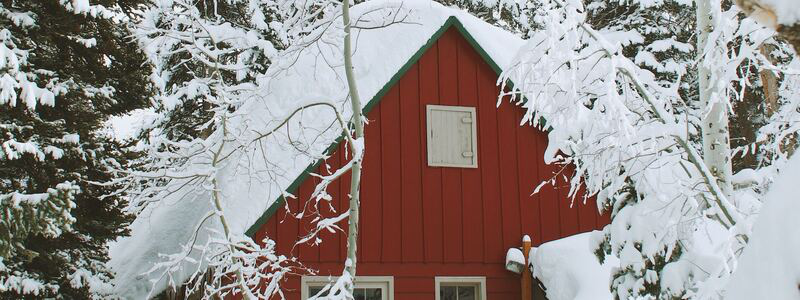
Fixing Plumbing Vent Boots
One of the common culprits behind roof leaks, especially during winter, is the plumbing vent boots. These essential components can become damaged over time, leading to unwanted moisture intrusion. In our Winter Roof Repair Tips, we’ll guide you through the process of inspecting and fixing plumbing vent boots to ensure a leak-free roof.
Understanding Plumbing Vent Boots:
- Plumbing vent boots are installed around plumbing vents, sealing the gap between the vent and the roof.
- They consist of a plastic base, metal top, and rubber boot surrounding the pipe.
- Damage to any of these parts can lead to leaks.
Inspecting the Vent Boots:
- Check the plastic bases for cracks or broken seams.
- Examine the rubber boot surrounding the pipe for tears or wear.
- Look for loose or missing nails at the base.
Repairing or Replacing Vent Boots:
- If the boot is in good shape but nails are loose, replace them with rubber-washer screws.
- If any part of the vent boot is broken or damaged, purchase a new plumbing vent boot.
- Follow the manufacturer’s instructions for installation, or consider hiring a professional if you’re unsure.
Safety Considerations:
- Always use caution when working on the roof, especially in winter when surfaces may be slippery.
Consider using a roof harness or working with a partner for added safety.
Fixing plumbing vent boots is a vital part of winter roof maintenance. While some repairs can be done on your own, don’t hesitate to reach out to B&M Roofing if the task seems too complex or if you prefer professional assistance. Our team is skilled in all aspects of roof repair, including plumbing vent boots, and we’re here to ensure your roof remains secure and leak-free all winter long.
Fixing a Leaky Chimney
Chimneys add character and warmth to a home, but they can also be a source of leaks, particularly during the harsh winter months. The flashing around brick chimneys is often susceptible to rust and damage, leading to unwanted water intrusion. In this section of our Winter Roof Repair Tips, we’ll explore how to identify and fix a leaky chimney, ensuring a cozy and dry winter season.
Identifying Chimney Leaks:
- Look for water stains or dampness around the chimney area inside the house.
- Inspect the flashing around the chimney for rust, cracks, or detachment.
- Check the mortar and bricks for signs of wear or damage.
Quick Fixes for Leaky Chimneys:
- Slip new flashing under the old rusted flashing to drive water downhill temporarily.
- Apply a waterproof sealant to small cracks or gaps as a short-term solution.
Long-Term Solutions:
- Replace the flashing altogether, ensuring proper installation and sealing.
- Consider repointing or rebuilding the chimney if the mortar or bricks are severely damaged.
- Hire a professional roofing contractor like B&M Roofing for a thorough inspection and repair.
Safety and Considerations:
- Working around chimneys can be complex and requires proper tools and safety measures.
- If you’re unsure about the repair process, it’s best to consult with a professional.
Chimneys are more than just aesthetic features; they play a vital role in venting your home. Ensuring their integrity is essential for both safety and comfort. While some minor repairs can be handled independently, a leaky chimney often requires professional attention. B&M Roofing’s experienced team is ready to assist with all your chimney repair needs, providing expert solutions that last beyond the winter season.

Fixing Step Flashing
Step flashing is a critical component in roof construction, especially where walls intersect with the roof. It helps in draining water downhill over the shingles, preventing leaks. However, when damaged, water can run underneath it and into your house, leading to significant problems. In our Winter Roof Repair Tips, we’ll guide you through the process of identifying and fixing step flashing to ensure a watertight roof.
Understanding Step Flashing:
- Step flashing consists of metal pieces bent at a 90-degree angle, placed between each course of shingles and the adjoining wall.
- It acts as a barrier, directing water away from the wall and onto the roof.
Identifying Damaged Step Flashing:
- Look for water stains or leaks inside the house near walls that intersect with the roof.
- Inspect the step flashing from the outside for rust, detachment, or other visible damage.
Repairing or Replacing Step Flashing:
- If the flashing is slightly damaged, it may be repaired with a roofing sealant.
- If the flashing is extensively damaged, it must be replaced.
- Carefully remove the damaged flashing and shingles, and replace them with new materials, ensuring proper overlap and sealing.
- Consider hiring a professional if the task seems complex, as improper installation can lead to further issues.
Safety Considerations:
- Use proper safety equipment, such as a roof harness, especially during winter when the roof may be slippery.
- Work with a partner or consider professional assistance if you’re unsure about the process.
Step flashing is an essential but often overlooked aspect of roof maintenance. Proper care and timely repair or replacement can prevent costly water damage inside your home. B&M Roofing is here to assist with all your step flashing needs, providing expert guidance and professional services to ensure your roof remains secure throughout the winter and beyond.
Choosing an Expert Team at Roofing
B&M Roofing has extensive experience in residential and commercial roofing, with a Colorado company providing quality service throughout the Centennial State since 1947.
The premier Colorado commercial roofing contractor uses only the highest quality roofing shingle suppliers: GAF and Owens Corning. We offer a wide range of colors and styles to choose from, ensuring that we can match the right roof shingle color to any home’s style.
We work with brands like GAF and Owens Corning to offer you a variety of roofing materials and colors to choose from and allow you to find the perfect color for your home. B&M is always available to help give your home’s roof the beauty it deserves.
How to Prepare Your Roof for Winter
As winter approaches, it is crucial to ensure your roof is adequately prepared to withstand harsh weather conditions. Properly winterizing your roof protects your home and helps maintain its structural integrity.
In this article, we will discuss key points on how to prepare your roof for winter, including tips for winterizing, protecting your roof from snow, and the best temperature for roof repairs. Considering these guidelines will help you ensure a well-maintained and durable roof throughout the winter months.
Preparing Your Roof in The Fall
Don’t wait for freezing weather. Take action when the fall arrives. Add the following to the checklist and contact a professional team to assist you with winterizing your roof:
- Inspect the roof for damage
- Clear debris and clean gutters
- Check insulation and ventilation
- Seal air leaks
- Schedule a repair or replacement if needed

Conduct a Roof Inspection
Before winter arrives, perform at least a thorough inspection of your roof from the ground to identify any existing or potential issues. Look for obvious signs of damage, such as missing or damaged shingles, cracks, or loose flashing. Inspect the condition of your roof’s surface and pay attention to any areas of concern.
Identifying and addressing problems early on can prevent further damage during winter storms.
If you are unsure about conducting the inspection yourself, get in touch with a professional roofing contractor like B&M Roofing that can provide expert guidance and ensure a comprehensive evaluation. While inspecting your roof from the ground can provide a general overview, it is advisable to hire a professional for a more comprehensive assessment.
We have the expertise to identify potential issues that may go unnoticed by the untrained eye. By addressing these issues promptly, you can prevent further damage during winter storms and ensure the longevity of your roof.
Trim the Trees
If you have large trees around your house, plan to trim any branches that hang over your roof. During the winter, snow can accumulate on those branches, potentially causing them to break and crash onto your roof. Consider hiring a landscaping company to take care of any large branches you cannot safely reach. Trimming the trees will reduce the risk of damage and ensure the safety of your roof during winter storms
Clean and Clear Your Roof
Clearing debris from your roof is essential to prevent clogged gutters and potential water damage. If you can do it safely, remove leaves, twigs, and other debris that may have accumulated on your roof. Clean gutters and downspouts to ensure proper water drainage. Clogged gutters can lead to ice dams, which occur when melted snow freezes and forms a barrier, preventing water from flowing off the roof. Ice dams can cause water to back up under the shingles and potentially seep into your home, resulting in leaks and water damage.
Regular maintenance and cleaning will help prevent these issues and keep your roof functioning optimally.
Insulate and Ventilate Your Attic
Proper insulation and ventilation in your attic play a significant role in maintaining a warm and energy-efficient home during winter. Insufficient insulation can lead to heat loss, which can contribute to the formation of ice dams on the roof.
Check the insulation levels in your attic and consider adding more if necessary. Adequate insulation helps retain heat within your home, reducing the strain on your heating system and minimizing the risk of ice dams.
Furthermore, ensure that your attic is adequately ventilated to regulate temperature and humidity levels. Proper ventilation helps prevent excess moisture buildup, which can lead to mold growth and potential roof damage.
Seal Air Leaks
Air leaks in your home can contribute to heat loss and increase your energy bills. Inspect your roof and attic for gaps, cracks, or openings where warm air can escape.
Common areas for air leaks include around chimneys, vents, and attic hatches. Seal these areas with weatherstripping, caulk, or spray foam insulation to improve energy efficiency and reduce the chances of ice dam formation on your roof.
By sealing air leaks, you create a more airtight and well-insulated environment within your home, helping keep it warm and comfortable during winter.
Consider Roof Repair or Replacement
If your roof has significant damage or is nearing the end of its lifespan, it may be wise to consider repairs or replacement before winter arrives. Cold weather can make roofing tasks more challenging, and some roofing materials have temperature limitations for installation. If there are visible signs of damage, such as missing or damaged shingles, leaks, or sagging areas, consult with a professional roofing contractor to determine the best course of action.
At B&M Roofing, we can assess the condition of your roof and provide recommendations for repairs or replacement based on your specific situation.
How to Protect Your Roof from Snow
Heavy snowfall can stress your roof significantly, potentially leading to structural damage. To protect your roof from the weight of accumulated snow, consider installing snow guards. Snow guards are devices that are strategically placed on your roof to prevent large amounts of snow from sliding off all at once. By holding the snow in place, they reduce the risk of injury from falling snow and minimize the strain on your roof.
Snow guards also allow the snow to melt and drain more gradually, preventing the formation of ice dams.
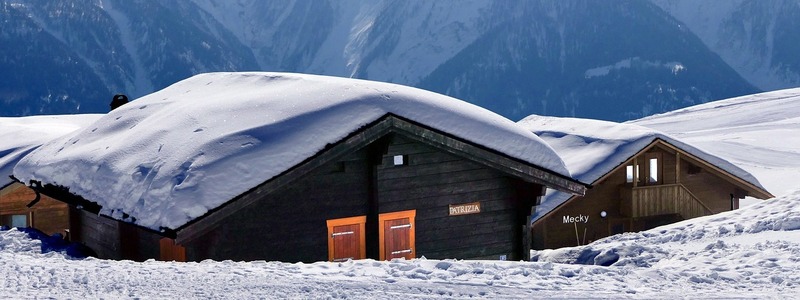
Ideal Temperature for Roof Repairs or Replacement
Roofing materials have specific temperature requirements for installation. Cold temperatures can make shingles and other materials brittle, making them more prone to damage during installation. It is generally recommended to avoid roofing tasks when the temperature falls below freezing (32 degrees).
Professionals have the expertise and knowledge to determine the best temperature and weather conditions for successful roof repairs or replacement. Do not, however, wait for everything to freeze before you call.
Why Not Do It Myself?
There are several reasons not to attempt DIY roof inspections and repairs. DIY inspections and repairs are very unlikely to save you money. They will surely leave issues unaddressed, your roof vulnerable to the elements and may shorten your roof’s lifespan, resulting in an urgent and premature need for roof replacement.
Risk
Walking around on your roof can be extremely dangerous, even for experienced individuals. Professional roofing contractors undergo countless hours of safety training, use special safety equipment to minimize risks, and still, accidents happen. No amount of money saved is worth risking your life.
Don’t hesitate to reach out to our expert team; we have the training and experience to inspect and repair your roof correctly. We know how to spot damage and how to make appropriate repairs to save you from urgently having to pay for things that could be avoided.
Material Warranty
Moreover, manufacturers of roofing materials require a licensed roofing contractor to install their materials for said material to qualify for their warranty. On the off chance you were to tackle your DIY roof repair successfully, you’ll have missed out on these warranties. If and when your repairs go bad, you’ll be stuck paying for more materials or, worse, for a completely new roof.
DIY roof repair isn’t worth the accompanying headache. At B&M Roofing, you get a licensed roofing contractor to perform biannual roof inspections safely.
Allow trained eyes to spot unseen wear and tear. Rest peacefully, knowing that your roof is in good shape as it endures season after season. The peace of mind from a qualified licensed contractor’s genuine interest in your well-being is abundant.
What Roof can Withstand Extreme Weather?
Some roofs fit into snowy conditions in Colorado more than others.
- Metal roofs can handle heavy snow and allow it to slide off easily.
- Cement roofs, although less common due to their cost, offer great protection against snow. They are durable and can resist moisture.
- Slate roofs are both beautiful and strong, capable of withstanding snow and ice. However, slate is expensive.
Overall, these roofs provide durability and resilience against the snowy weather conditions in Colorado.
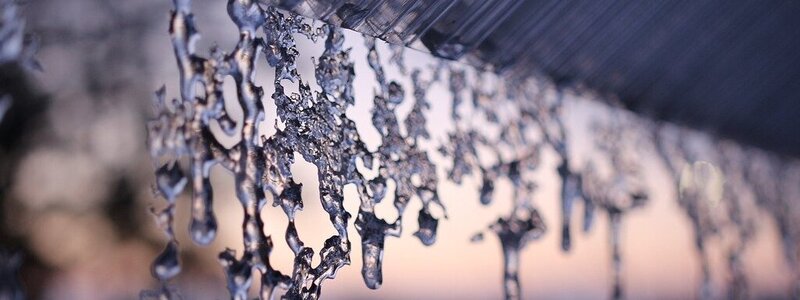
Inspect and Prepare
Preparing your roof for winter is essential for its longevity and for protecting your home from the elements. Adhering to temperature guidelines while planning roofing tasks ensures optimal results. With proper preparation, your roof will withstand the winter season, providing you with peace of mind and a comfortable living environment.
Our professional team has the experience to inspect, repair and replace your roof. Contact us to discuss how we can help you, schedule a convenient time to visit your house, and allow our team to give you customized solutions.
B&M Roofing Colorado’s Most Trusted
If you think it’s time to replace your roof, regardless of the size of your home, this is an important decision that you should not rush into. You need to make sure you choose the right roofing installation company, that the roof is installed correctly and that the weather cooperates during the replacement process.
For more information about roof maintenance, repair, or replacement. Call us at 303-816-0068 or fill out a contact form.
Roof Replacement Process
A roof replacement is a significant home improvement project that requires careful planning and execution. Whether due to age, damage, or a desire to enhance your home’s esthetic appeal and functionality, understanding the roof replacement process is crucial.
This article will provide you with valuable insights into the steps involved in roof replacement, and answer common questions about the process, materials, insurance, and more.
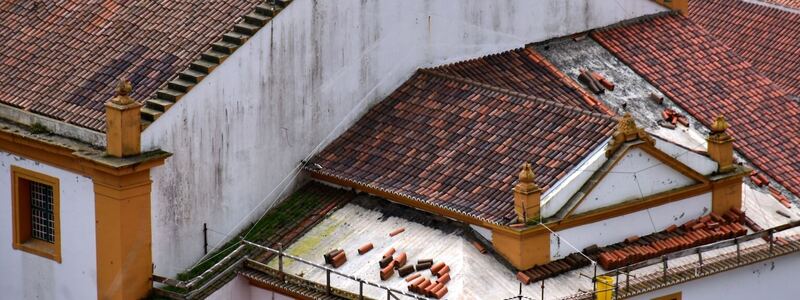
The Roof Replacement Process
The roof replacement process typically follows a series of steps to ensure a successful and long-lasting outcome. While each roofing company may slightly vary its processes, the core steps remain consistent.
Sometimes, if the existing roof is in relatively good condition and local building codes permit, it may be possible to install new roofing materials directly over the existing roof. This approach can save time and money, but it’s essential to consider factors like weight restrictions and the condition of the underlying structure.
Here is an overview of the most common roof replacement process:
Inspection and Assessment
A professional roofer assesses the condition of the existing roof, identifying any signs of damage or underlying issues. They examine the roof’s structure, decking, insulation, and ventilation systems to ensure optimal condition.
Obtaining Permits
Depending on your local regulations, permits may be required before commencing a roof replacement project. Your roofing contractor will assist in obtaining the necessary permits to ensure compliance with building codes.
Material Selection
Choose the roofing materials that best suit your needs, preferences, and budget.
Removal of Existing Roof
The old roofing materials are carefully removed, ensuring the underlying structure remains intact. The removal process may involve stripping off shingles, underlayment, flashing, and other components.
Repair and Preparation
Damaged or rotted sections of the roof decking are replaced. The roof surface is inspected for any necessary repairs or reinforcements before the installation of new materials.
Installation
The new roofing materials are installed according to the manufacturer’s guidelines and industry best practices. This includes laying underlayment, applying shingles or other chosen materials, and installing flashing and ventilation systems.
Cleanup and Inspection
The job site is thoroughly cleaned of debris, ensuring the surrounding areas are safe and tidy. A final inspection is conducted to verify the quality of the installation and address any remaining concerns.

Common Questions About Roof Replacement
- Should I stay home during the roof replacement?
While you don’t need to stay home during the entire roof replacement process, it is advisable to be present during critical stages such as the initial inspection, material selection, and final inspection. This allows you to stay informed, address any concerns, and ensure that the project progresses smoothly.
- Do roofers need to come inside the house?
Roofers generally do not need to enter the interior of your home during a roof replacement unless some specific requirements or issues need to be addressed. Most of the work is conducted externally, focusing on the roof structure itself.
- How long does a roof replacement take?
The duration of a roof replacement project varies depending on several factors, including the roof size, weather conditions, and the efficiency of the roofing crew.
A roof replacement can take a few days to a couple of weeks. Your roofing contractor will provide a more accurate timeline based on your project.
Contact our experienced team at B&M Roofing today for a free estimate!
Types of Roof Pitches and Examples
Roof pitch refers to the slope or angle of a roof. Different roof pitches serve specific purposes and are used in various building types. Here are some common types of roof pitches:
Low Slope Roofs
Roof Pitch 2:12 to 4:12
Examples include flat roofs, low-slope metal roofs, and modern architectural designs.
Conventional Slope Roofs
Roof Pitch 4:12 to 9:12
Examples include traditional gable roofs, hip roofs, and shed roofs commonly found in residential homes.
Steeper Slope Roofs
Roof Pitch: 9:12 to 21:12
Examples include Victorian-style roofs, Dutch gable roofs, and French country roofs.
High Slope Roofs
Roof Pitch 21:12 and above
Examples are Gothic-style roofs, Tudor-style roofs, and some barn roofs.
You can use a simple method to determine the pitch or slope of your roof. Find a point on your roof and measure how steep it is. You can figure out the pitch by looking at how much the roof goes up compared to how far it extends horizontally. Another option is to consult a professional roofer who has the tools and knowledge to assess the pitch of your roof.
Commonly Used Roofing Materials
Asphalt Shingles: Most popular roofing material due to affordability, durability, and ease of installation. Available in various styles and colors, providing versatility in design.
Metal Roofing: Offers exceptional durability, longevity, and energy efficiency. Common materials include steel, aluminum, and copper.
Tile Roofing: Provides a classic and elegant look, often seen in Mediterranean or Spanish-style architecture. Materials include clay and concrete tiles, offering durability and resistance to fire and rot.
Slate Roofing: Known for its natural beauty, durability, and longevity. Requires professional installation due to its weight and specialized handling.
Wood Shakes and Shingles: Offers a rustic and charming appearance, commonly used in traditional and historic homes. Requires regular maintenance and may have restrictions in fire-prone areas.
Synthetic Roofing Materials: Engineered to mimic the appearance of natural materials like slate or wood shakes. These are cost-effective alternatives with improved durability and reduced maintenance.

Roofing in Colorado: Aspects to Consider
Roofing in Colorado has some specific characteristics and considerations compared to other states due to the state’s unique climate, geography, and building codes.
Weather Conditions
Colorado experiences a wide range of weather conditions throughout the year, including heavy snowfall, intense sunlight, high winds, and occasional hailstorms. These weather elements can impact the longevity and durability of the roofing materials used.
Due to the high elevation and exposure to sunlight, roofs in Colorado are prone to faster deterioration from UV rays. Choosing roofing materials that can withstand UV radiation and extreme temperature fluctuations is crucial.
Snow Loads and Ice Dams
Colorado’s mountainous regions receive significant snowfall during winter. Roofs need to be designed and constructed to withstand the weight of heavy snow loads.
Proper insulation and ventilation are essential to prevent the formation of ice dams, which can cause water infiltration and damage to the roof structure.
Wind Resistance
The state experiences strong winds, particularly in open plains and mountain areas. Roofs must be designed and installed to withstand these wind forces.
Selecting appropriate roofing materials, fastening methods, and adherence to local building codes regarding wind resistance ensures the roof’s stability.
Impact Resistance
Impact-resistant roofing materials, such as impact-rated shingles or metal roofing, can provide increased protection against hail damage.
Building Codes and Regulations
There are specific building codes and regulations related to roofing to ensure safety and structural integrity. These codes may include requirements for wind resistance, snow load calculations, ventilation, insulation, and fire ratings.
It’s important to work with roofing professionals knowledgeable about Colorado’s building codes and ensure compliance with these regulations during roof installation or replacement.
Energy Efficiency
Colorado residents often prioritize energy efficiency due to the state’s temperature variations and the desire to reduce utility costs. Roofing materials with high thermal insulation properties, such as cool roofs or energy-efficient shingles, can help maintain a comfortable indoor temperature and reduce energy consumption.
When considering roofing in Colorado, it’s crucial to consult with experienced roofing contractors familiar with the specific challenges posed by the state’s climate and building codes.
Roof Replacement by Professionals | B&M Roofing
B&M Roofing has extensive experience in residential and commercial roofing, with a Colorado company providing quality service throughout the Centennial State since 1947.
The premier Colorado commercial roofing contractor uses only the highest quality roofing shingle suppliers: GAF and Owens Corning. We offer a wide range of colors and styles to choose from, ensuring that we can match the right roof shingle color to any home’s style.
We work with brands like GAF and Owens Corning to offer you a variety of roofing materials and colors to choose from and allow you to find the perfect color for your home. B&M is always available to help give your home’s roof the beauty it deserves.
Dark Shingles vs Light Shingles
When it comes to selecting the perfect shingle color for your roof, the choices can seem overwhelming. While both dark and light shingles offer their unique aesthetic appeal, it’s crucial to consider various factors to make an informed decision. In this article, we will explore the debate between dark shingles and light shingles, helping you determine the ideal option for your Colorado home.
B&M Roofing, your trusted roofing company in Colorado, understands the significance of selecting the right shingle color to enhance your home’s overall appearance and functionality. Our team of experts has extensive experience in guiding homeowners through the process, considering regional climate, energy efficiency, and architectural style.
Whether you’re aiming for a bold and dramatic look or a more subtle and understated charm, understanding the benefits and drawbacks of dark and light shingles is essential. Join us as we delve into the world of shingle colors, providing you with valuable insights to make an informed choice that perfectly complements your Colorado home’s unique character.
There are many factors to consider when choosing between a light or dark roof before finalizing a color. The process might seem complex at first, but we’ve provided you with a brief overview to help you make the best decision for the structure.
Ultimately, the best color for your roof is the color you prefer, but we suggest sticking to neutral-colored shingles. A trendy color might make the building stand out, but how will you still love it in about 20-30 years? An off-beat color might also make it harder to resell your property down the road, which is why it’s best to stick to neutral tones. Shades of cream, tan, brown, gray, or black are safe colors that will be in style for many years.
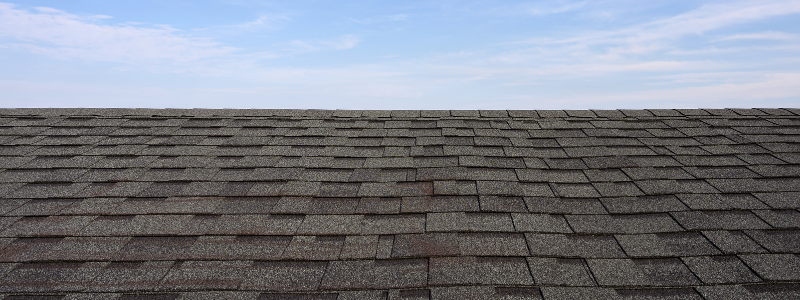
Dark vs. Light
When choosing a roof color for your property, both light and dark-colored roofs have definite advantages in appearance and functionality.
Go Towards the Light
However, in recent years, we’ve seen more property owners opt for light-colored roofs due to their energy-saving properties.
Despite being mainly known for its ability to reflect sunlight and heat away from your home or business, there are other benefits to choosing a light-colored roof; this includes modernizing the property, prolonged service life, and a reduced cooling load.
Energy Efficiency
As mentioned earlier, light-colored roofs are known for energy-saving capabilities. Your roof significantly impacts the temperature inside the building, and a dark roof is more likely to conduct a warmer temperature on the structure below, increasing cooling efforts such as air conditioning. Additionally, dark shingles can absorb enough heat that the surface can become hotter than the temperature outside.
A darker roof might seem beneficial for structures in colder climates as dark shingles can help melt the snow and ice more efficiently. However, the reduced energy load in the winter doesn’t seem to be sizable.
White or light-colored roofs reflect heat rays from the sun, keeping the attic and rooms below it cool during warm weather. As a result, the building’s cooling load decreases, helping home and business owners stay comfortable and save money on their energy bills.
Light-colored roofs are sometimes referred to as ‘cool roofs’ because they provide a reflective barrier, reducing the impact solar heat has on the building, which can help keep the temperature low on the inside and outside. Cool roofing methods can make a difference of 20-40 degrees, which can significantly reduce your property’s cooling costs.

Urban Heat Island Effect
Light-colored roofs can also lower the urban heat island effect, which causes metropolitan areas dense with concrete, buildings, and people to have a hotter temperature than the areas surrounding them. This effect is known for increasing air pollution levels and heat-related illnesses such as heat strokes. The urban heat island effect can also lead to strained energy resources due to the high cooling energy demand, further contributing to global warming.
Service Life
Heat plays a major role in the service life of your new roof. Dark-colored roofs are more prone to damage due to the high level of UV rays absorbed by the shingles; this can cause materials to crack, melt, blister, and fade.
A new roof can be very costly. Therefore it’s important to prolong the service life of your roof as much as possible.
Appearance
When it comes to choosing between dark and light roofs, the first thing you should consider is what would go best with the color of your home or business. The colors of the bricks, sliders, stuccos, or trims of the structure should complement whichever color you choose.
Take a look at the building’s architectural style and decide how your roof shingles can be coordinated with the exterior and the surrounding structures. Dark color roofs such as black and charcoal can execute more of a classic and traditional look. However, it can also make your property look smaller. In contrast, light-colored roofs can make a structure look more extensive and more modern.
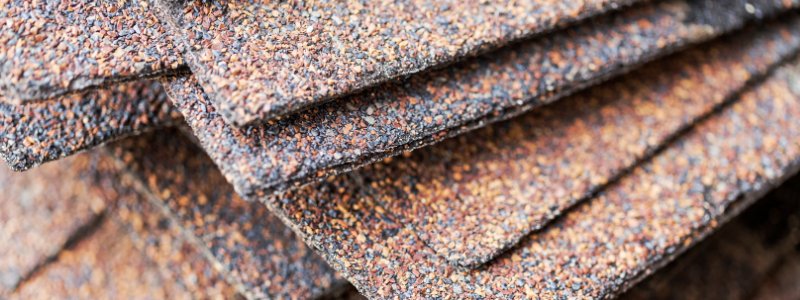
Choosing the right color that compliments the structure itself can make a huge difference in your property’s curb appeal.
Here are some classic color combinations:
| Roof Color | Exterior Color |
| Light Grey | White, Grey |
| Tan | White, Dark Red, Dark Green |
| White | Gray, White, Tan |
| Black | Dark Red, Gray, Tan |
| Brown | Dark Red, Brown, Tan |
Neighborhood Rules & Roofing Codes
Before finalizing a color for your roof, it’s essential to browse through the rules in place for your neighborhood and subdivision; this ensures that you don’t violate any regulations before you start the installation, as some bylaws might even require you to obtain a permit before construction. Also, be sure to be considerate to your neighbors as you want to make sure your new roof doesn’t clash with any surrounding properties.
Additional Factors
Property owners should keep in mind that factors other than color contribute to the building’s conduct and appearance. The type of roof materials used can also play a significant role; Asphalt shingles tend to absorb more heat and have a shorter lifespan, while clay and concrete tiles are more energy-efficient and tend to last longer. Additionally, quality of installation, proper ventilation, and regular inspection will naturally affect your roof’s longevity and energy-saving functions.
In the end, choosing the right roof color and material for your property can improve the appearance of your space, help you reduce utility costs, and help contribute to more significant energy-saving efforts. Request a free estimate from our team of experts, and let B&M Roofing make your roofing process easy and efficient.
B&M Roofing and Residential Roofing
B&M Roofing has extensive experience in residential and commercial roofing, with a Colorado company providing quality service throughout the Centennial State since 1947.
The premier Colorado commercial roofing contractor uses only the highest quality roofing shingle suppliers: GAF and Owens Corning. We offer a wide range of colors and styles to choose from, ensuring that we can match the right roof shingle color to any home’s style.
We work with brands like GAF and Owens Corning to offer you a variety of roofing materials and colors to choose from and allow you to find the perfect color for your home. B&M is always available to help give your home’s roof the beauty it deserves.
How to Prepare for Hailstorms
Hailstorms can be incredibly destructive, causing significant damage to homes and properties. For residents of Colorado, where hailstorms are a common occurrence, being prepared for these natural phenomena is essential. As a roofing company based in Colorado, B&M Roofing understands the importance of proactive measures to safeguard homes from hail damage.
In this article, we will provide valuable insights and practical tips on how to prepare for hailstorms. We will explore the necessary steps homeowners can take to minimize potential harm to their roofs, protect their belongings, and ensure the safety of their loved ones.
From inspecting the roof for vulnerabilities and reinforcing it with hail-resistant materials to installing protective coverings and implementing preventive maintenance strategies, we will delve into various approaches that can significantly reduce the impact of hailstorms on residential properties.
By adopting the proactive measures outlined in this article, homeowners can enhance their preparedness, safeguard their homes, and potentially avoid costly repairs or replacements in the aftermath of hailstorms. Let’s dive in and learn how to prepare for hailstorms effectively.
What is Hail?
If you live in Colorado, you know the damage hail can cause, but did you know that it is formed when water vapor in updrafts reaches a freezing point? Ice is formed and is suspended in the air by updrafts and falls down to be coated by water again.
This process can occur over and over again, adding several layers to the hailstone, which is how golf ball-sized hail can occur. While the average hailstorm only lasts five minutes, the damage can be extremely detrimental.
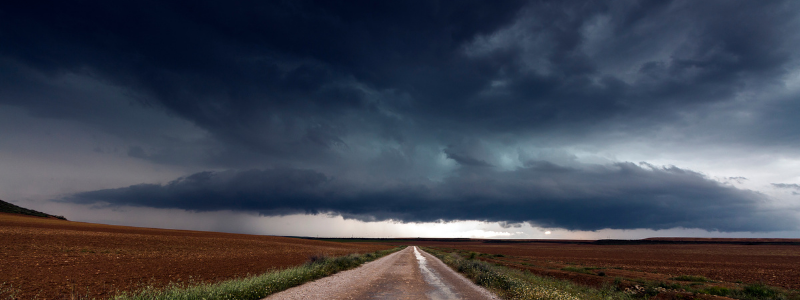
Signs of a Potential Hail Storm
There are a few signs that hail may fall, so if you notice these changes in the weather, start preparing. The sooner you prepare, the more you’ll be able to prevent hail damage.
- A solid (not gradient) wall of dark blue/grey clouds, in contrast with little-to-no clouds – These clouds bring a lot of moisture, along with a cold front. The two together mean a mixture of cold and rain.
- A sudden wave of wind gusts that are higher up in the air – A side draft (between updraft and downdraft) or fluctuating draft is a true sign that a violent thunderstorm is approaching.
- Thunder/lightning – This usually means rain is coming, and given the frequency, it could bring a quick hail storm, too. Not all thunderstorms bring hail, but all hail usually comes with a thunderstorm. So it’s good practice to be prepared any time you hear thunder.
- A quick drop in temperature – When it gets colder, it’s even colder in the atmosphere. This contributes to the creation of hail.
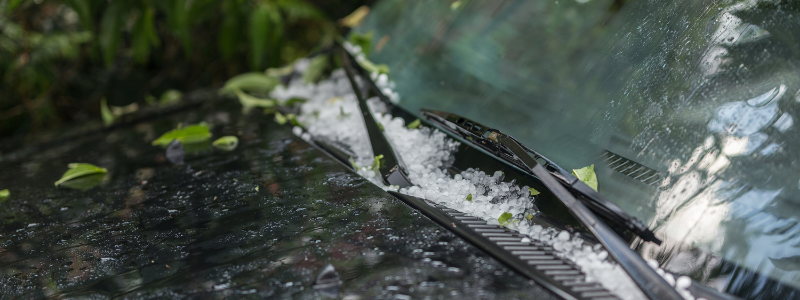
How to Prepare for Hailstorms
When it comes to hailstorms, preparation is key to minimizing potential damage to your home. By taking proactive steps and implementing preventive measures, you can protect your property and ensure the safety of your loved ones. Here are some essential tips on how to prepare for hailstorms:
- Inspect Your Roof Regularly
Perform a thorough inspection of your roof to identify any existing vulnerabilities. Look for signs of wear and tear, loose or damaged shingles, and weak spots that may be susceptible to hail damage. If you notice any issues, contact a professional roofing company like B&M Roofing to address the problems promptly.
- Reinforce Your Roof
- Install Protective Coverings
In areas prone to frequent hailstorms, installing protective coverings like hail guards or screens can provide an added defense for your windows, skylights, and other vulnerable areas. These coverings can help prevent shattered glass and minimize potential damage caused by hailstones.
- Trim Overhanging Trees
Trim any overhanging tree branches near your home, especially those that could potentially break or fall during a hailstorm. Falling branches can cause severe damage to your roof, siding, or windows when combined with hail impact.
- Secure Outdoor Items
Secure or move any outdoor furniture, equipment, or valuables that could be damaged by hail. Strong winds accompanying hailstorms can turn these items into projectiles, posing a significant risk to your property and others nearby.
- Have Emergency Supplies Ready
Prepare an emergency kit that includes essentials such as flashlights, batteries, first aid supplies, and non-perishable food items. Additionally, ensure you have a reliable method of communication, such as a charged mobile phone or a battery-operated radio, to stay informed about weather updates and emergency alerts.
By following these proactive measures and staying prepared, you can significantly reduce the impact of hailstorms on your home. Remember, the safety of your family should always be the top priority. If severe weather conditions are expected, consider seeking shelter in a designated safe area until the storm passes.
How to Prevent Hail Damage to Your Car
Cars can take quite the abuse from Colorado’s harsh weather, but there are a few ways you can protect your car from hail damage.
- Seek cover in covered parking/areas – If you’re on the road frequently (i.e. commuting) know where the closest parking garages are so you can safely ride out the storm. If you can’t reach a garage before the storm hits, pull under an overpass, gas station canopy, or similar spot that can help protect you and your car from hail. Even the overhang from trees may be enough to slow the hail down enough from damaging your car.
- Face the hail head-on – If you can’t find cover, drive into the hail so that the hail hits your windshield rather than your side and rear windows. Your windshield is much stronger than the other windows.
- Park on the side of the building, opposite of the wind direction – If overhead cover isn’t available, try and park on the opposite side of the building from the direction the wind is blowing. The hail may not reach your car as much.
- Use blankets to cover the car – If you can’t get your car to shelter, raid your linen closet and cover the car with any thick blankets, comforters, or even large towels. The more layers, the better!
- Use cardboard to cover the car – Cardboard may also serve as a good source of “padding” and protection against hail. Place it under your windshield wipers to keep them from moving around and the cardboard layers can usually take the brunt of the hail impact.
- Use floor mats to cover the car – If nothing else is available, your car’s floor mats are a great option to use as protection from hail. Place the floor mats carpet-side-up, under your windshield wipers. For side windows, you may have to wedge them up into the rubber window lining.
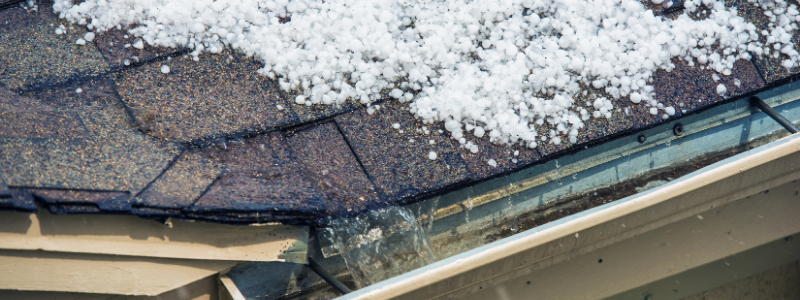
How to Prevent Hail Damage to Your Home
Some hail damage is inevitable, but there are a few good tips that will help limit damage, if any, to your home.
- Close curtains – Make sure to close any curtains or blinds, so that if your windows break, no glass or debris gets blown into the home.
- Trim trees/branches – While the weather is nice, be sure to maintain your trees and shrubbery in your yard. Especially for those taller trees that are closer to your roof, remove any weak branches.
- Protect outdoor furniture – Bring all patio and lawn furniture inside or under a covered area.
- Close umbrellas/canopies/tarps – Hail will rip these fabrics to shreds, so keep them closed when a storm approaches.
- Consider window coverings – Things like hinged shutters or metal awnings may be a good idea, as they’re easier to replace or repair than broken windows.
As we mentioned, some hail damage to your home is inevitable, like damage to your roof. Your home’s roof may take the brunt of the hail impact, but the cost to fix/repair/repair roof shingles is much less compared to other things in and around your home.
How to B&M Roofing Can Help With Hail Damage
B&M Roofing isn’t just another “storm chaser” company. We’re local, we’re experienced, and we’re honest. We’ve seen a hail storm or two and know just exactly what types of damage to expect and look for. If we can save you costs, we will.
- Roof inspections – Call B&M Roofing to inspect your roof shingles for wind or hail damage after a hailstorm.
- Durable, storm-grade materials – The roofing materials offered by B&M Roofing are the most impact-resistant roofing materials, proven to be able to withstand Colorado weather. We only work with the most trusted roofing material companies.
- Proactive maintenance – Early in the spring months, like March or April, we can take some preventative measures with preparing your roof for the hail season.
After a serious hailstorm, be sure to call your insurance company to schedule a damage assessment and then give B&M Roofing a call to make any necessary repairs. At B&M Roofing, we service everything from small residential roofs to large, complicated commercial properties throughout Colorado and surrounding areas.
Best Roof For Hail
Hailstorms can cause significant damage to homes and property. Hailstones can range from golf ball size to baseball-sized. The force of these stones can break windows, shatter glass doors, and even dent vehicles.
There are some areas such as Colorado that are prone to hail during April and into July. Therefore, having the best roof for hail will provide protection and help anticipates the damage. There are several types of roofs that can withstand strong winds and heavy rain.
In this article, we will be discussing what are the best roofs and materials that will endure hail.
Damage Caused by Hail on The Roof
In Colorado, you will be familiar with the damage that hail can cause to your roofs. Even though a hailstorm may only last a couple of minutes, it can cause disastrous damage in that short amount of time to your roof.
Hail can do multiple things to your roof, it can not only damage your roof but also damage other elements of the roof. Such as the chimney, gutters, vents, and skylights. Alongside that, hail can crack the shingles, (except the hail resistant shingles) and weaken the seals on your roof, just to name a few.
All of these things then lead to leaks starting to form in our roof, which can lead to further damage in your home. As a result, it is important to stay on top of any damage that is caused to your roof. Thus, if you notice any damage to your roof or suspect any damage, then you call a professional to inspect your roof.
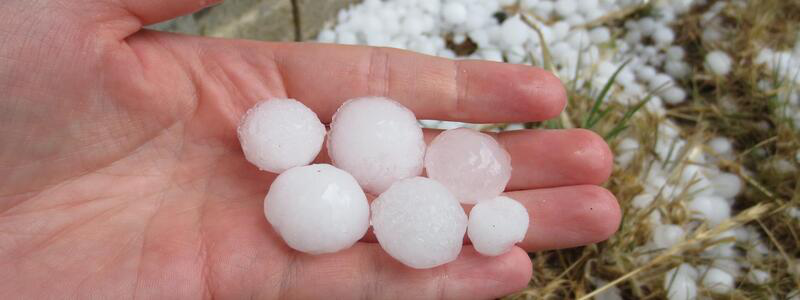
What Is The Best Roof for Hail Storms?
There are many kinds of best roofs for hail storms that can be used for protecting your home. Some of them include:
Metal Roofs
Metal roofs have been around for years, and they still remain one of the most popular best roof for hail. They are made out of metal sheets that are attached together with screws, nails, etc. Metal roofs are very durable and long-lasting, which makes them an excellent choice for protecting your home from severe weather conditions. However, there are some cons associated with using metal roofs. One of the main con there is the chance that if the hail is big enough, it can dent the roof, especially if you have a flat roof.
Thicker metal panels are much more durable as they can deflect the hail. Yet over time, the impact of multiple hail storms will begin to show.
Impact-Resistant Shingles
Asphalt shingles are a popular choice for residential roofs, and luckily, there are impact-resistant options available. These shingles are specially designed to withstand the force of hailstones. They are constructed with reinforced fiberglass matting and have a higher impact resistance rating than standard shingles. Impact-resistant shingles can help minimize the risk of damage and prolong the lifespan of your roof.
Slate or Tile Roofs
Slate and tile roofs are renowned for their resilience and longevity. These materials have a natural resistance to hail damage due to their solid and robust composition. Slate and tile roofs can withstand the impact of hailstones without sustaining significant damage. While they may be a higher initial investment, they offer exceptional durability and an elegant appearance.
Rubber/EuroShield Roofs
Synthetic roofing materials, such as synthetic slate or rubberized shingles, are gaining popularity due to their hail-resistant properties. These materials are engineered to mimic the look and durability of natural materials while providing additional impact resistance. They can withstand hailstorms without cracking or breaking, offering excellent protection for your home.
These rubber roofs are very sturdy as they absorb all the impact caused by the hail. Thus, the hail easily bounces off the roof. Alongside that, rubber roofs are made from recycled tires and come in various styles and colors. Yet, they are an eco-friendly option that are also very low maintenance.
Tile Roofs
Tile roofs can be made from slate, clay, concrete, or ceramic and will last for many years. This type of roof is ideal for hailstones that are smaller than 2 inches. However, if the hail is any bigger, then the chances of the tiles breaking or chipping is increased, which may also not be covered by some insurance companies.
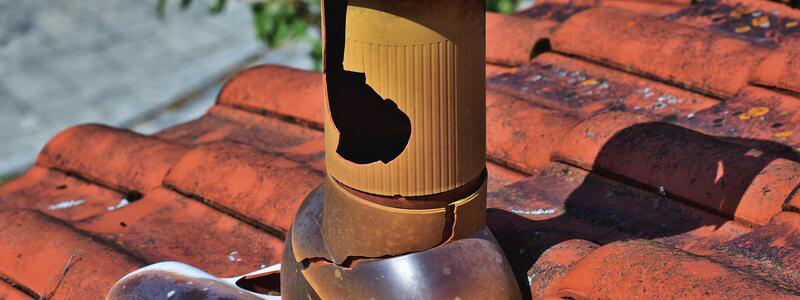
Class 4 Hail Resistant Metal Roof
A class 4 hail-resistant metal roof is the highest impact rated roof you can get your hands on. They can withstand hail that is around 2 inches big. Often these roofs are made from aluminum, copper, asphalt, plastic or resin shingles.
These roofs can also stand 110 miles per hour winds and are a great long term investment. If you want a roof that will give you long-term protection from hailstorms, then you may want to consider a class 4 roof. Especially, as their impact rating is so high, you will have to spend less money on this roof for maintenance or replacement costs.
F-Wave Roofs
An F-wave roof is another low-maintenance roof that is very durable and lightweight. They also have a class 4 hail rating and can withstand 130 miles per hour winds. When you purchase an F-wave roof there is the option to have roofs that look similar to slate, asphalt or cedar shakes.
An F-wave roof is one of the few roofs that have a hail warranty, which is very handy when it comes to living in Colorado.
What Materials Are Hail Proof?
Hailstorms can wreak havoc on our homes, causing extensive damage to roofs and leaving us with hefty repair bills. Therefore, it’s natural to wonder if there are any materials that are hail-proof. While no material can claim to be completely immune to hail damage, some options offer higher levels of resistance than others. Let’s explore a few materials known for their hail-resistant properties:
- Metal Roofing: Metal roofs, typically made of steel, aluminum, or copper, are highly regarded for their durability and resilience. Metal panels are inherently strong and can withstand the impact of hailstones. Additionally, their smooth and slippery surfaces allow hail to slide off more easily, reducing the risk of damage. Metal roofs are a popular choice in hail-prone areas due to their ability to deflect hailstones and minimize potential harm.
- Stone-Coated Steel: Stone-coated steel roofing combines the strength of metal with a protective layer of stone chips. This combination creates a highly durable and hail-resistant material. The stone coating adds an extra layer of protection against hail impact and helps to absorb and distribute the force. Stone-coated steel roofs are an excellent choice for areas susceptible to severe hailstorms.
- Synthetic Roofing Materials: Synthetic roofing materials, such as synthetic slate, rubberized shingles, or polymer-based tiles, offer a hail-resistant alternative to natural materials. These synthetic options are engineered to withstand the impact of hailstones without cracking or breaking. They are designed to be flexible and durable, providing a high level of resistance to hail damage. Synthetic roofing materials are a popular choice for homeowners seeking both durability and aesthetic appeal.
- Concrete and Clay Tiles: Concrete and clay tiles are known for their robustness and ability to withstand harsh weather conditions. These tiles are naturally resistant to hail impact due to their solid composition. The density and thickness of concrete and clay tiles provide excellent protection against hail damage. However, it’s worth noting that extremely large hailstones or severe hailstorms can still cause some level of damage to these materials.
While these materials offer a higher level of hail resistance compared to others, it’s important to remember that no roof is entirely hail-proof.
In severe hailstorms with unusually large hailstones, even the most resilient materials can sustain some damage. However, choosing hail-resistant materials can significantly reduce the risk and extent of damage to your roof.
When considering hail-resistant materials, it’s essential to consult with roofing professionals who have expertise in hail-prone regions. They can provide guidance on the best materials for your specific climate and help you make an informed decision based on your needs and budget.
Are Metal Roofs The Best for Hail Storms?
Yes, metal roofs are better for hail because they are very durable and strong. As we mentioned before, the only thing that could damage a metal roof is a large hail storm. Even then, the chances of damaging the roof are minimal.
Metal roofs are also very easy to install and maintain. You do not need to worry about any special tools or skills needed to install a metal roof. All you need to do is attach the metal sheets together with screws, nails etc. Once the roof is installed, you just need to make sure that you keep it clean and free of debris.
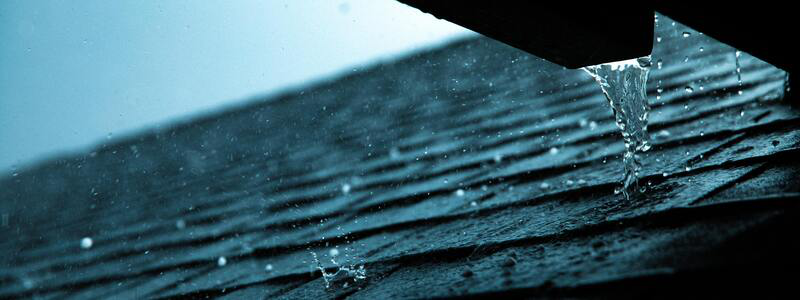
What Can I Do To Protect My Roof From Hail?
If you live in an area where hail storms are common, then you should take steps to protect your roof against the effects of hailstorms. The best way to do this is to choose a good roof system for your home. A roof that has been designed specifically for hail resistance will help to protect your home from hailstorms.
Alongside that, when the weather is nice, you should keep your trees and shrubs maintained. If you have tall trees, then you should remove any branches that are considered weak. Otherwise, when a hail storm occurs, these branches could fall down and damage your roof.
Your home also needs to be protected by hail alongside your roof. To protect the rest of your home, you should close any blinds or curtains so that if any windows break during the storm, no glass will be blown into your home. Also, hinge shutters are a great idea to have installed. This is because they are much easier to repair or replace than a broken window.
Finally, any outdoor furniture must be put under a covered area or brought inside to keep them safe. Also close all tarps, umbrellas or canopies in the garden. Otherwise, the hail storm will destroy the fabric. So it’s best to keep them closed.
Protect Your Roof with B&M Roofing Colorado
In Colorado, hail storms are very popular and can cause a lot of damage to your roof. Hence, having a metal or rubber roofs could help prevent your roof from being damaged due to hail.
At B&M Roofing, we inspect your roofs for hail damage, and offer you durable and hail resistant materials to be used on your roofs. We will also offer you preventive measures in the spring before the hail season.
Call us today at 303.938.9642 to schedule a visit from our emergency repair team or visit our leak repair request page to submit your information and have one of our team members contact you.
Our 24/7 support line is here to help immediately with emergency roof repair. Calling sooner means less of a wait and more opportunities to repair before extensive damage is done. We offer work throughout Colorado, including:
- Denver
- Colorado Springs
- Fort Collins
- Boulder
- Greeley
- Rocky Mountain areas
- Surrounding states including Wyoming, Utah, Kansas, Nebraska
Popular Roof Shingle Colors
The roof of a home is one of the most important and expensive investments homeowners make. It protects the house from the elements and contributes to its overall look and aesthetics. Choosing the right color for a roof is a big decision that should take with seriousness. It can be daunting to decide where to start with many available options.
This article explores the most popular roof shingle colors for residential properties and discusses the latest trends and styles.
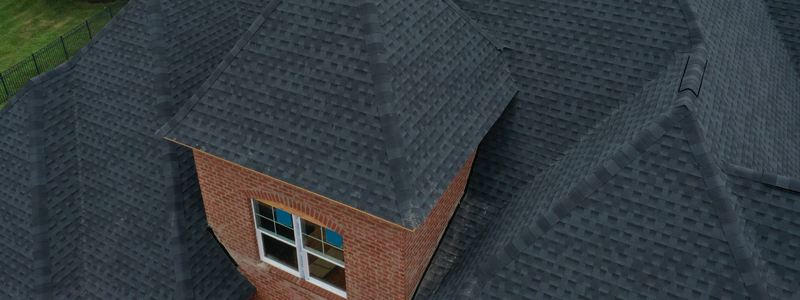
What is the Most Popular Shingle Roof Color?
According to a recent survey, the most popular shingle roof color is black.
Black roof shingles are a timeless and versatile color that has remained a popular choice for many homeowners. Its classic and sophisticated appearance is perfect for both traditional and modern homes, making it a popular choice for many architectural styles. The color black is also great for hiding dirt and stains, which is why it is commonly better for roofing.
However, black is not the only popular color, as homeowners are also choosing shades of gray, brown, and blue to enhance the look of their homes.
Lighter roof colors are better for energy efficiency and they don’t get as hot as black shingles under the sun. So, if you’re looking to have a more energy-efficient roof, light roof shingles are popular roof shingle colors.
What are the Most Popular Roof Colors for 2023?
As we move into 2023, there is a growing trend toward more natural and earthy colors for roof shingles. The natural world inspires these colors, which are perfect for homeowners looking for colors that complement their environment and enhance the look of their homes.
Shades of brown, tan, and green are becoming increasingly popular as they often reflect the natural beauty of the surrounding landscape.
These colors are perfect for homes with natural and organic architectural styles, such as stone and wood accents. They are also easily coordinated with other design elements, such as siding, shutters, and door colors. This makes them a common option for homeowners who want a cohesive and harmonious look for their homes.
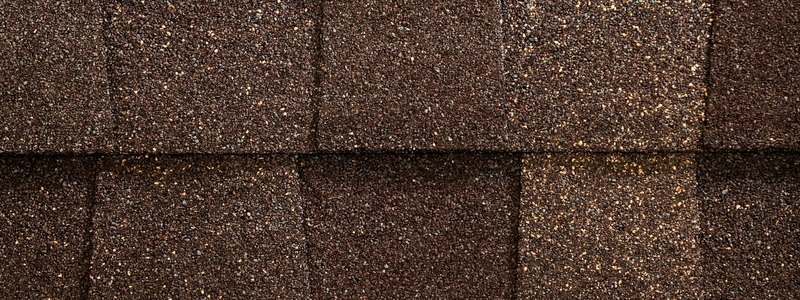 Brown roof shingles are an excellent option for those who want a color inspired by nature.
Brown roof shingles are an excellent option for those who want a color inspired by nature.
Brown roof shingles come in various shades, including light beige, chocolate brown, and deep caramel, which makes it easy to choose a color that matches the overall design of a home. Brown roof shingles are perfect for homes with natural and organic architectural styles, such as stone and wood accents.
Tan roof shingles are another popular color in 2023.
They are perfect for homeowners looking for a natural, earthy color that is easy to coordinate with other design elements. Tan roof shingles come in various shades, making it easy to choose a color that matches the overall design of a home. They are also ideal for homes with a traditional or classic architectural style.
Green roof shingles are a unique and eye-catching color that is perfect for homeowners who want to make a statement with their roofs.
Green roof shingles come in various shades, including light green, forest green, and sage green. This makes it easy to choose a color that matches the overall design of a home. Green roof shingles are perfect for homes with a natural and organic architectural style and those with a modern or contemporary design.
What is the Shingle Color of 2023?
Owens Corning is a well-known manufacturer of roofing materials, including shingles, and they have recently announced their 2023 Shingle Color of the Year: Midnight Plum.
This new color option for their Duration® Designer shingles is expected to be very popular among homeowners who are looking for a modern and sophisticated color palette for their roofs.
Midnight Plum is a rich, deep shade of purple that offers a unique look for residential roofing. This color is a perfect blend of blue and red tones, creating a distinct hue that can complement various exterior design styles. It is a versatile color that can work with a range of home styles, from traditional to contemporary. It can be an excellent choice for homeowners who want to make a bold statement with their roofing color.
In addition to its striking appearance, Owens Corning’s Duration® Designer shingles are also designed for durability and longevity. They are made with patented SureNail® Technology, which ensures they stay in place even in high winds. They are also engineered with StreakGuard™ Algae Resistance Protection, which helps prevent the growth of algae, protecting the appearance of the shingles over time.
Midnight Plum is just one of many color options available from Owens Corning for their Duration® Designer shingles. This color is expected to be in high demand for 2023 and beyond, especially as homeowners continue to look for ways to add curb appeal to their homes. If you’re in the market for new roofing, Midnight Plum may be an excellent option to consider for its unique and modern look.
What is the Most Popular Roof Trend for 2023?
In 2023, the trend for roofing is tending towards natural and earthy colors such as shades of brown, tan, and green. These colors, inspired by nature, complement many architectural styles. They are also easily coordinated with other design elements like siding, shutters, and door colors.
Aside from color, homeowners prefer high-quality, long-lasting roofing materials that can withstand harsh weather and provide long-term protection for their homes. GAF and Owens Corning, for example, provide a wide range of roofing materials and colors to meet the needs of homeowners in terms of both style and durability.
Colorado’s Weather and Roof Shingle Color Selection
In Colorado, the weather can often be extremely harsh, with hot summers and cold winters. Colorado’s weather can cause roof shingles to fade, discolor, crack, or become brittle.
Therefore, homeowners in Colorado need to choose a roof shingle color that can withstand the elements and maintain its appearance over time. Homeowners should consider the overall appearance of their home and the climate and weather conditions when choosing a roof shingle color.
Shades of brown, tan, and green are popular roof shingle colors in Colorado, as the inspiration is by nature and complements a wide range of architectural styles. They are also easily coordinated with other design elements, such as siding, shutters, and door colors. Black and gray are also popular roof shingle colors in Colorado, as they are timeless and versatile. These colors are perfect for homeowners who want a classic and sophisticated look for their homes.
It’s important to consider the color and durability of the roof shingles when choosing a roof shingle color in Colorado. GAF, Owens Corning, and other roofing shingle suppliers provide a wide range of roofing materials. These come in different colors specifically made to withstand the elements and provide long-term protection for Colorado homes. Choose an appealing roof shingle color whether you are constructing a new house or remodeling an existing one. It must also provide adequate protection for your home in Colorado’s harsh climate.

B&M Roofing and Residential Roofing
B&M Roofing has extensive experience in residential and commercial roofing, with a Colorado company providing quality service throughout the Centennial State since 1947.
The premier Colorado commercial roofing contractor uses only the highest quality roofing shingle suppliers: GAF and Owens Corning. We offer a wide range of colors and styles to choose from, ensuring that we can match the right roof shingle color to any home’s style.
We work with brands like GAF and Owens Corning to offer you a variety of roofing materials and colors to choose from and allow you to find the perfect color for your home. B&M is always available to help give your home’s roof the beauty it deserves.
Roofing Companies Denver
There are different roofing companies in Denver, Colorado, and B&M Roofing is one of the industry leaders. These roofing companies render different services, ranging from commercial to residential. So, irrespective of your roofing needs, a roofing company in Denver, Colorado, can cater to your needs.
But what exactly can you expect from these roofing companies in Denver? Is it important to hire one? And who are the top roofers in Denver? This article answers these questions and more.
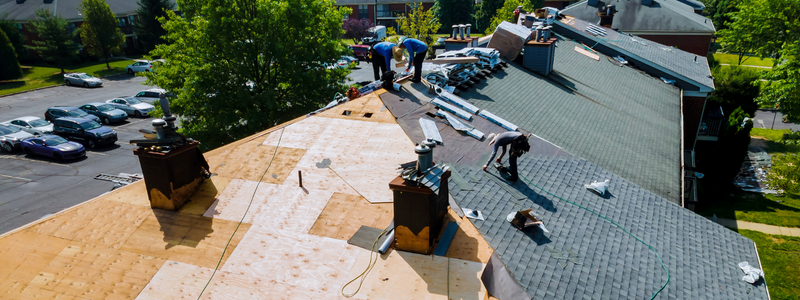
What Do Roofing Companies Do in Colorado?
Before discussing what roofing companies do in Colorado, it is essential to explain the different types of roofers there are in Denver, Colorado.
- Commercial Roofers: Commercial roofing services focuses on installing or replacing flat roofs and other industrial applications. They focus primarily on commercial construction and sometimes carry out residential projects.
- Residential Roofers: As the name implies, residential roofing services focus on personal homes. Residential roofers work on shingle and metal roof installation, maintenance, repair, and replacement.
- Industrial Roofers: Industrial roofing services deal with maintaining and repairing industrial roofs. Industrial roofers focus on metal roofs and industrial applications.
- Roofing Contractors: This refers to roofers who work on commercial and residential buildings. If you need a general contractor, it is best to go with roofing contractors in Denver, as they have experience in both roofing types. Also, roofing contractors act as a one-stop shop for all your roofing needs.
Now, what do these roofing companies in Colorado do?
Roof Installation
Roof installation is quite common, and it involves putting a new roof on your house or business structure. Installing a new roof takes time and requires the expertise of seasoned roofers. So, carefully choose the roofing company to handle this project.
Roof Repair
Roof repair is another common service rendered by roofing companies in Denver. However, unlike roof installation, the focus here is on fixing any damaged part of your roof. For this to happen, the roofing contractor will assess the damage and tell you what repair the roof needs.
Roof Replacement
Replacement is different from repair. Here, you might have to haul an entire section rather than fix a damaged part of the roof. This makes roof replacement a job for the experts, so hire a reputable roofing company.
Removal of Waste and Cleaning of Debris
Most roofing companies offer waste removal and cleaning of debris on the rooftop as part of their services. This service is particularly sought after a heavy storm or other acts of nature damage the rooftop.
Emergency Services
Colorado is no stranger to storms like hail, tornados, snow storms, etc., and it causes severe damage to rooftops. You can contact a roofing contractor that renders emergency services in such instances. These services are available all week long for 24 hours.
Why Is It Important to Hire a Roofing Company in Denver?
Aside from using top-notch roofing materials when roofing your home, the roofing contractor you work with ensures you get a well-installed roof. To this end, it is prudent to work with a local roofing company in Denver. The following are several reasons why you should choose a local roofer:
- You can verify their licenses and references, as local businesses thrive on referrals.
- Local roofing companies in Denver know local building codes that must be met. Therefore, there are fewer avenues for issues with non-compliance, which might delay your roofing project.
- Working with local roofers gives you access to quick and prompt service delivery. Also, you can contact them easily or visit their office if there’s an issue with the roof.
- You get easy access to emergency services in case of storms or serious accidents that impact your roof.
- You get better-personalized service as local Denver roofers dedicate their time to their customers, something roofing companies outside the may be unable to offer.
Do Commercial Roofers Need to be Licensed in Denver?
Yes. Generally, Colorado classifies roofing contractors — including commercial roofers — as general contractors. As such, they are not required to carry a special state license. However, they must have a business license, which shows that the company has been active for a minimum of two years.
A roofing company must have a valid and current business license to obtain a permit for an extensive project. In addition to the preceding, they must carry a Class D-Roof Covering and Waterproofing license. If the roofing project involves significant structural work, the roofing contractor needs a Class A or Class B General Contractor License.
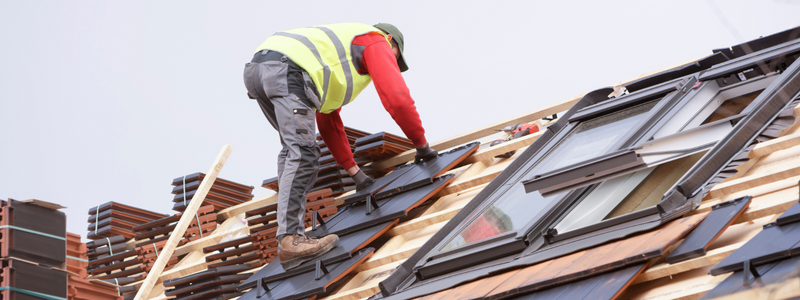
How to Select the Best Roofing Company in Denver
Just because a roofing company is one of the best in Denver does not mean they are the right fit for you. So how do you select the best roofing company for your needs?
Here are some helpful tips:
- Research the company online and check past client reviews
- Speak to your neighbors and ask them the company that handles their roofing job
- Visit the company’s website to familiarize yourself with their services
- Find out the company’s years and level of experience
- Compare prices with other roofing companies in Denver
- Interview the roofing company and stay objective
- Check to see if the company has a free estimate system
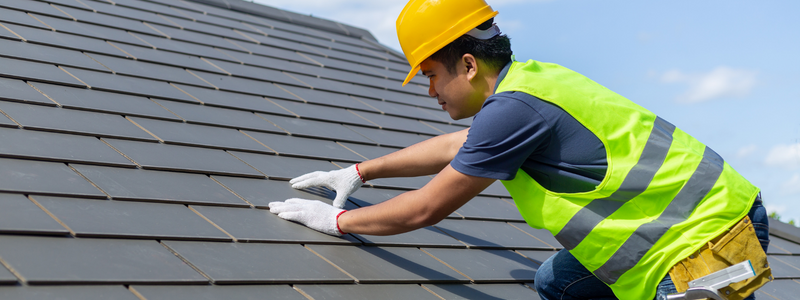
Trust B&M Roofing With Your Roofing Needs
At B&M Roofing, we are committed to rendering top-notch services to all our residential and commercial clients. We are available all year, whether you need repairs, installations, or replacements. So, request a free estimate today!





































